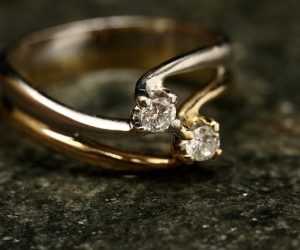Jewelry comes in all shapes, styles, and sizes. And these days, it’s a pretty exciting area. That’s because there are literally thousands of artisans out there, all crafting stunning items for our collective enjoyment. It’s not an industry dominated by a few big businesses, making it a wonderful place to explore.
Many people keen on buying jewelry, though, have no idea which metal to choose. Sure, they know about gold and silver (which we will include below). But there are so many other metals out there, too, suitable for making rings, bracelets, necklaces, and even watches.
What’s amazing is that each metal has its benefits and disadvantages. And most people simply aren’t aware of them. It turns out that there are dozens of different types of materials out there you can fashion into rings, bracelets, and whatever else you want.
This post takes a look at the top materials for making jewelry. Here’s a rundown:
Platinium
You probably thought gold would be at the top of the list of jewelry metals. But, in truth, it’s platinum.
Platinum is (usually) more expensive, ounce for ounce than pure gold. It’s also much harder than gold, which means that manufacturers don’t need to mix as many alloying metals with it to make pieces of jewelry. Platinum is okay on its own.
The reason you don’t see all that much platinum in jewelry stores is that it is so rare. Furthermore, not everyone knows about it.
Platinum melts at an incredible 3,216°F. It also never tarnishes like gold and is mixed with other metals, like cobalt, to give it its shiny, silver appearance.
You may sometimes see “platinum group metals” mentioned but note that these are different. Scientists are referring to other metals that are near to platinum in the periodic table but aren’t actually platinum itself.
Gold
Coming in at number two on the list is gold.
Gold is a soft metal, meaning that if you knock it, it’ll deform. That’s why bullion suppliers always sell gold bars in rigid plastic cases. It protects the gold inside from damage which could reduce its value.
You can get 24K fine gold jewelry, but it is weak. Therefore, most jewelers combine gold with other substances, including zinc and copper. These metals reduce the gold content to 18K or 12K but improve the strength and durability considerably.
Don’t worry: you can always recover the pure gold afterward if you need to. The alternative is to wear 24K gold, but you must be exceptionally careful.
Pure gold metal will never tarnish. You could leave it at the bottom of the ocean for a thousand years and it will look the same as the day you threw it in.
10K gold is only 41 percent gold and the lowest concentration you can legally call gold.
You can also get gold-plated jewelry where jewelers apply a micro-thick layer of gold ions to the surface of another metal. Here, the gold content is tiny, perhaps just 0.05 percent of the weight of the piece.
You can also get something called gold-filled. Here, jewelers wrap a thin strip of gold around the cheaper metal. The total gold content is around 5 percent in this case, though it can vary significantly from one maker to another.
Tungsten
Coming in at number three on the list will be a bit of a surprise to many people: tungsten.
Tungsten has many industrial and commercial applications. Manufacturers, for instance, use the substances to harden drill bits.
Tungsten, though, is another great option for jewelry, as firms like The Artisan Rings make clear.
Tungsten, for instance, is four times stronger than platinum. It is also the second hardest substance known, with only pure diamond being stronger.
What’s more, it looks great, is affordable, and won’t cause any allergies. Unlike cobalt and nickel, tungsten is hypoallergenic.
When you pick up tungsten, it has a weighty feel. It’s a bit darker than platinum, so it doesn’t have the same shine, but most people can’t really see the difference.
Men, in particular, love tungsten wedding bands because of their masculine appearance and durability. You can knock it up significantly, and it won’t affect the base metal at all. People in physically demanding occupations, such as construction work, roofing, and climbing love the material for their jewelry.
Of course, if resale value is more important to you, then platinum might be the better option. However, if you want something unique and special that most people won’t have seen before, then tungsten could be the better option.
Palladium
Coming in at number four on the list of best jewelry metals is palladium. Palladium is popular because of the metal’s brilliant white sheen and the fact that it is significantly lighter than other platinum-group metals.
Palladium’s popularity comes from its price. It’s around a half to a third of the price of gold for the same size but offers many of the same properties. For instance, it won’t tarnish on the scale of human lifetimes, and it’s hypoallergenic.
Interestingly, palladium is actually more expensive than gold. However, jewelry made of metal is usually more expensive because palladium is not as dense as gold. (The volume taken up by an ounce of gold is far less than a similar volume taken up by palladium). Therefore, you need less metal to make a particular piece of jewelry.
Moreover, palladium has the strength of platinum, which is significantly tougher than gold. This means that you can wear it with confidence in normal situations, without worrying about tarnishing or it getting bashed.
The downside is that palladium jewelry is hard to find. The general public doesn’t know much about it, so relatively few people actually buy it. Moreover, they tend to confuse it with other precious metals, including platinum.
Not many jewelers know how to work with it, either, keeping it out of the market.
Titanium
Most people assume that titanium is an aerospace metal occasionally found on bicycle frames. But you can also make it into jewelry.
Why is titanium popular? Again, like the other metals on this list, it is hypoallergenic and doesn’t tarnish easily. (A thin layer of titanium dioxide forms on the surface, protecting the rest of the metal inside).
It’s also one of the hardest metals, making it tougher than steel and all precious metals. Being scratch-resistant, it is popular for the same reasons as tungsten. But it has the added benefit of being extraordinarily lightweight for its strength, hence why aircraft manufacturers use so much of it.
There’s just one problem: titanium is notoriously difficult to work with. You can only weld it in an airtight environment. And the material requires extreme forces to bend and manipulate it. Therefore, you’ll only find titanium jewelry in basic shapes if you can locate it at all.
White Gold
White gold is an alloy of gold, usually containing around 41 percent pure gold with added platinum, zinc, copper, and other alloys to give it strength. White gold isn’t actually white at all. In its pure, uncovered form, it retains a slight golden hue from the underlying gold metal. However, jewelers coat it with a layer of rhodium, a lustrous white metal that looks similar to pure platinum when polished.
Rose Gold
Rose gold is a gold alloy with a higher percentage of copper. Unfortunately, copper is highly reactive, which means that rose gold will tarnish over time, particularly if you expose it to sweat and water. The gold content, however, will remain intact and undisturbed.
You can also get something called green gold. This is where jewelers leave copper out of the alloy entirely.
Silver
Silver comes in two main forms: pure or fine silver and Sterling silver.
Jewelers don’t usually make items out of fine silver. That’s because it is too weak, like pure gold. However, they do make it from Sterling silver, which is 92.5 percent silver, and the rest is other metals, like copper, that make it stronger.
Silver’s biggest appeal is that it is related to gold, sitting in the same metal group on the periodic table. It’s also incredibly cheap, only a fraction of the price of the other metals discussed in this list.
The downside is that it will eventually take on a gray color if it has copper in it. It also scratches easily, which is why old silverware and rings look so terrible.
Silver, though, is easy to reforge, and you can replace it at a low cost. When new, it is hard to tell silver and platinum apart. Both look roughly the same. It’s also easy to maintain this type of jewelry. By simply researching how to clean sterling silver, you can keep your accessories in good condition. This kind of jewelry is less likely to be tarnished but when it does, cleaning techniques are easy. For instance, you can use dish soap and warm water or baking soda and aluminum foil to remove the tarnish. You can also use jewelry wipes specifically designed for silver cleaning.
Like gold, you can also get “silver-filled” products which cut down on the price even more. Here, jewelers put a cheap metal in the middle and then wrap a thin layer of silver around it. The silver shouldn’t wear off, even after prolonged usage. However, if you damage items, the metal underneath will show through.
So there you have it: our list of the top metals for jewelry. Which will you choose?



